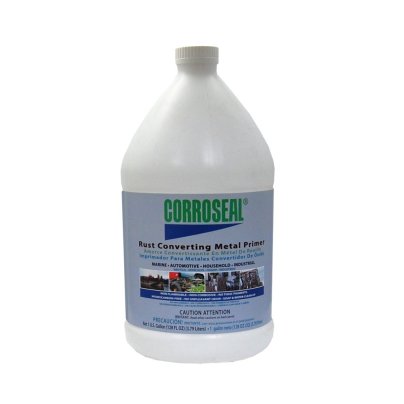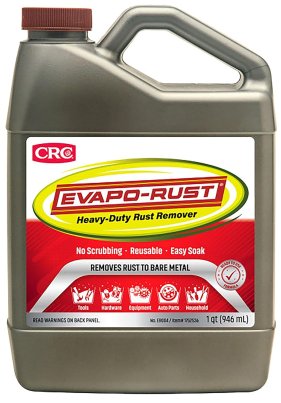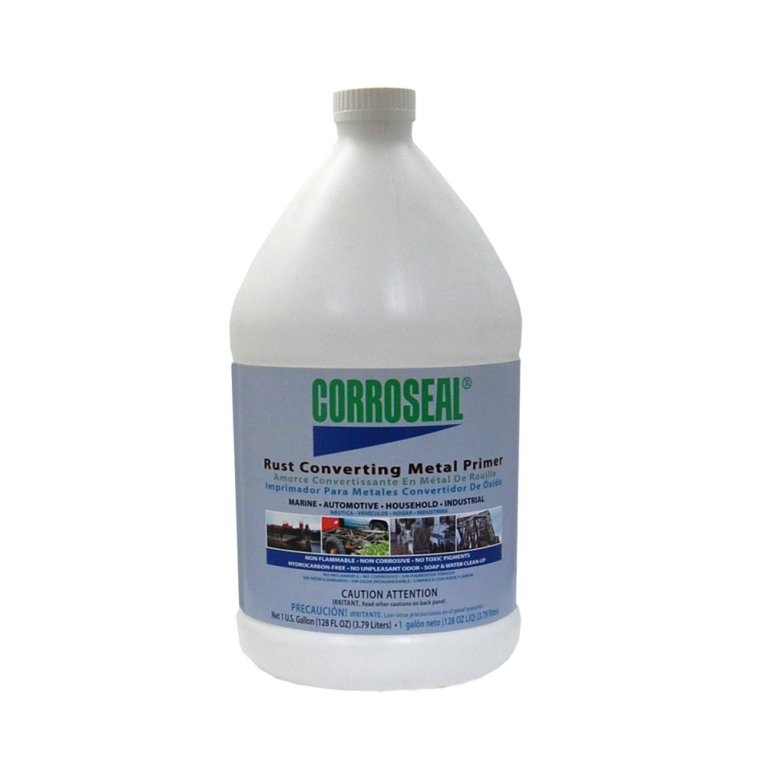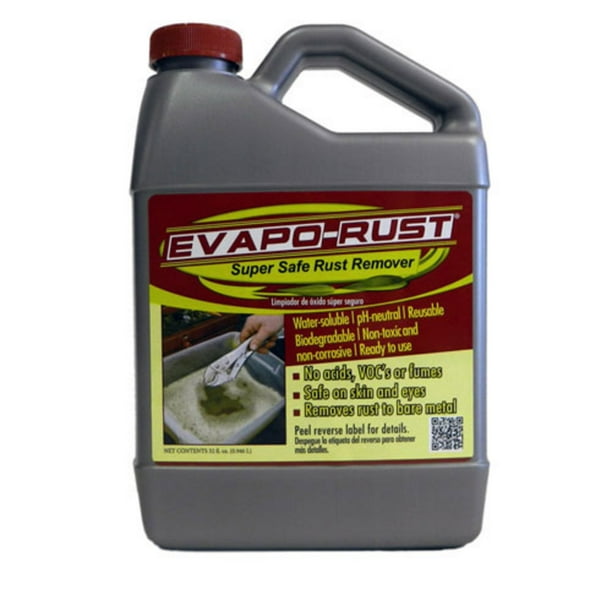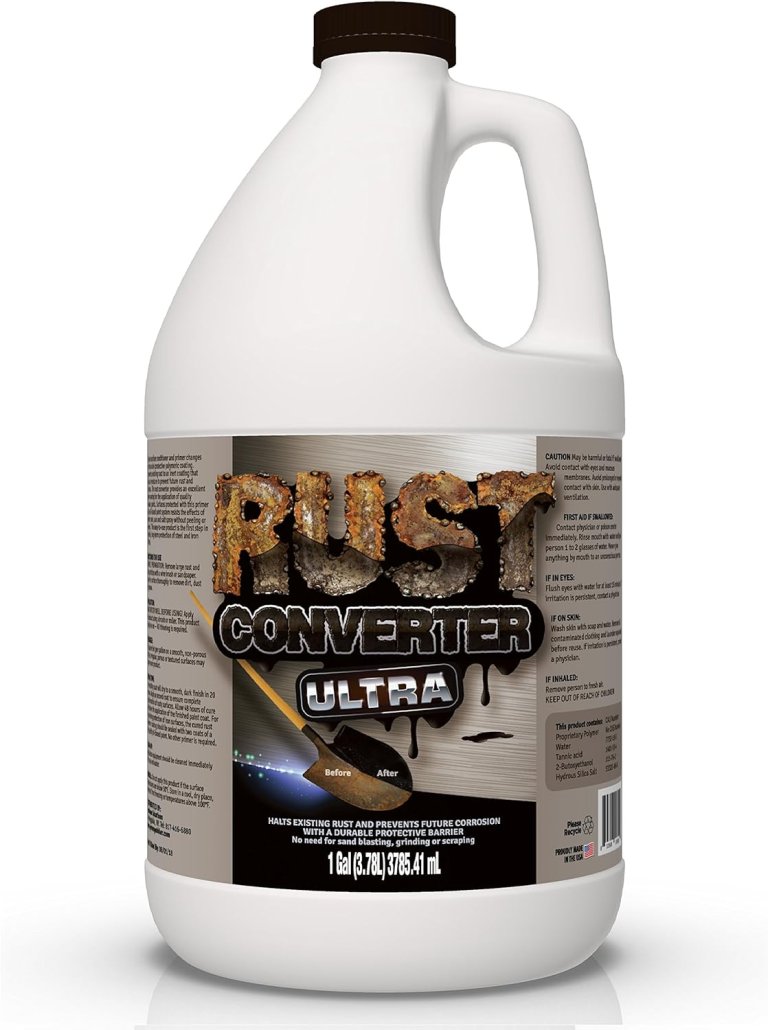We may earn revenue from the products available on this page and participate in affiliate programs. Learn more ›

If you’ve ever faced years of rust and corrosion on metal parts, you know just how annoying it is to remove and how damaging it can be. Over time, rust can literally eat away at metal, leaving you with big problems.Unfortunately, rust isn’t easy to get rid of once it forms. However, there are solutions, like rust converters and removers.
With a rust converter and remover, you can apply a chemical that actually takes oxidation—or rust—and makes it disappear. These products can even offer protection against future rust and corrosion, as they literally “convert” rust into a new, surface-protecting material. If you’re hoping to get rid of rust and keep your car and its metal parts, we’ve got the best rust converters and removers you’ll want to consider.
Summary List
- Best Overall: Corroseal Water-Based Rust Converter
- Best Value: Rust-Oleum Automotive Rust Reformer Spray
- Honorable Mention: Evapo-Rust The Original Super Safe Rust Remover
- Best for Light Rust: FDC Rust Converter Ultra
- Best for Easy Coverage: Rust Kutter Rust Converter
Our Methodology
A good rust converter and remover needs to work on all levels of corrosion, and that’s where the search for the best products in this category starts. The products here were chosen for their effectiveness on small spots of rust or larger, more significant corrosion, as well as extra benefits like protection from future corrosion in those same spots.
Additionally, I took a look at details like the amount of rust converter solution offered, its application method, and its suitability for different needs, from auto work to household use. The top rust-tackling converters and removers were those that were also highly recommended by user reviews, as they performed best in a variety of real-world use cases across the board.
Best Rust Converter Reviews & Recommendations
Best Overall: Corroseal Water-Based Rust Converter
Pros
- One-step application process
- Water-based, non-flammable formula
- Industrial-strength effectiveness
- Easy to clean up
Cons
- Does require sanding before use
- Expensive
Corroseal is widely regarded as the best rust converter paint and metal primer available today. Corroseal is easy to apply with a one-step process of using a paintbrush or a roller. Though it doesn’t come in a spray bottle, if you have your own, it is thin enough to use as a spray. Corroseal’s superior performance is most noticeable when it comes to the number of coats needed. While most rust converters need at least two coats, Corroseal can usually finish a job with just one. This also means you need less product per job, so one gallon should last longer than the competitors. An additional highlight of this product is that it has a water-based formula. This helps make it incredibly safe for use, Corroseal also guarantees that it’s non-flammable and non-corrosive. While still being an industrial-strength product, it is easy to clean up with just soap and water.
Although Corroseal is one of the best rust neutralizers, it is not perfect. To achieve the best results, this product does require sanding where some products don’t require prep work at all. Corroseal is also a bit more expensive than other options.
Best Value: Rust-Oleum Automotive Rust Reformer Spray
Pros
- Easy application
- Can be sprayed from any angle
- Instantly bonds with rust scales
- Stops rust from spreading
Cons
- Requires constant shaking
- Need multiple cans to cover large areas
Spray Rust-oleum Rust Reformer on any rusty surface and it instantly bonds with the scales to weaken them and make them easier to brush off. It also stops the rust from spreading to other uncontaminated parts. Just as with most rust treatment formulations, this also forms a protective primer layer that can be painted over. It comes in an aerosol bottle featuring any-angle spray technology, which lets you spray it in a back and forth motion, with overlapping strokes, or while the bottle is upside down. It dries in about 40 minutes and you can paint over the treated surface after 24 hours.
While it may be fairly easy to use, you need to constantly shake the bottle for the formula to spray out evenly and work properly. Additionally, you need more than a 10-ounce can to tackle more extensive projects.
Honorable Mention: Evapo-Rust The Original Super Safe Rust Remover
Pros
- Non-toxic and eco-friendly
- Water-based, non-flammable formula
- Highly versatile for many applications
- Won’t warp or damage plastic, rubber, or paint
Cons
- Does require surface prep
- Works best when items are submerged or soaked
Evapo-Rust is the best rust removal product for anyone who wants an eco-friendly solution. While this product is a rust remover and not a rust converter, it has many unique qualities that make it an excellent alternative for projects where converters are used. The safety of this product cannot be overstated. While a lot of removers use phosphoric acid, this water-based formula allows it to be non-toxic, non-flammable, eco-friendly, and completely biodegradable. Users can apply Evapo-Rust to cookware, utensils, and grill grates without worrying about harmful effects later on. Even more impressive is that this safe formula will not warp or damage any plastic, rubber, or painted parts. This is useful when it comes to storing for later use. While most rust converters will only activate once (when being applied), this formula can be used repeatedly.
Along with all of its positive attributes, Evapo-Rust comes with some negatives. While you don’t need to scrub the metal surface to take off the rust, this remover does require prep work to the corroded substrate. The rust remover does not protect parts from future corrosion, meaning that piece will rust again if not protected. Also, this remover works best when the rusted item can be submerged in the formula, making it less than ideal for larger projects.
Best for Light Rust: FDC Rust Converter Ultra
Pros
- Covers large areas
- Suitable for automotive and other uses
- Dries in under half an hour
- Acts as a primer coating
Cons
- Requires surface prep before use
- Works best on thin layers of rust
FDC offers one of the best formulas for eliminating recurring rust on iron surfaces. It comes ready to use and one gallon is enough to cover about 500 square feet of a non-porous, rusted surface. It dries after only 20 minutes and converts rust into an inert polymer coating with a black finish. This layer seals out moisture and prevents further rusting.
Once fully cured, it leaves a primer coating that can be used as a base for high-quality oil-based paint. When used as a primer, the painted surface will be more resistant to the harsh effects of rain, sun, and salt spray. The product is recommended for automobiles, machinery, railings, and other rusty surfaces.
Though it’s easy to use, surface preparation can be quite tedious before you can apply the rust converter— it only works well on a thin layer of rust. First, you need to thoroughly clean dirt and grease from the surface and use a wire brush to get rid of the large rust deposits before you can apply the converter.
Best for Easy Coverage: Rust Kutter Rust Converter
Pros
- Turns rust into phosphate coating
- Seals out oxygen and moisture
- Spray nozzle makes covering rust easy
- For automotive and other uses
Cons
- Can ruin clothing or fabric
- May require multiple bottles for serious rust
The Rust Kutter is formulated to eliminate rust and corrosion from any metal surface by converting it into a phosphate coating. The coating then latches onto the metal to keep out moisture and oxygen to prevent further corrosion.
The formula also works to prime the metal to ready it for a fresh coat of paint. It takes about 24 hours to dry, after which you need to rinse it away and leave the treated metal to dry. Apart from automotive detailing, you can also use it for home applications on any surface that tends to rust. It comes with a sprayer for easier application and better coverage.
However, it can destroy clothes and fabrics, so be sure to wear protective clothing and cover any non-metal surface while using it. Also, one bottle may not be enough to remove heavy rust buildup.
Our Verdict
The best rust converter and remover is the Corroseal Water-Based Rust Converter, an easy-to-use product that primes the surface of vehicles, boats, and other rust-prone items, giving you plenty of versatility and value. And it’s highly effective at its job, too. If value is key for you, another solid choice is Rust-Oleum Automotive Rust Reformer Spray, an affordable product that can remove rust with a little elbow grease.
Rust Converter Buying Guide
Types of Rust Converters
Liquid
The most common type of rust converter and rust remover is liquid. While the individual products will have varying thicknesses, the application process is generally the same. After some prep work, the chemical can be painted on, submerged, or sprayed on with your own spray gun. The best and easiest method is going to depend on your specific project.
Gel
Rust converter also comes in a gel form. These products are thicker than liquid removers, so they cannot be used with sprayers. One benefit they have over liquid is that you don’t have to worry about the product dripping if applied heavily. The gel can be painted or rolled onto the metal surface and allowed to dry for the best results.
Aerosol Spray
While some of the liquid removers can be used with a spray gun, some rust-removing products come as an aerosol spray. Typically, this can be a faster application process. However, be aware that it might be hard to use a spray can for extensive restoration projects due to their smaller quantities.
Rust Converter Pricing
You don’t have to make a big investment in order to get a quality rust remover. These products are available for under $10, and you’ll get enough of the formula—in a convenient spray bottle, most often—to cover small, isolated areas of surface rust. The products in this price range are best for rust that’s newly or recently formed.
Step up to the $10 to $25 range, and you’ll find an even wider array of rust converter and remover products. You’ll have more formulas and more types available to choose from, and you’ll also be able to select small or gallon-sized bottles. You’ll also find slightly stronger formulas within this price range, which are ideal for especially stubborn rust.
FAQs
You’ve got questions. The Drive has answers.
Rust removers are used to completely remove rust from the metal surface of a corroded part. Rust converters chemically bond to the rust, which stops the corrosion from spreading and also conceals the existing rust altogether.
Rust converters can be used on iron and steel, making them perfect for frames and other structural pieces.
Rust converters use phosphoric acids and polymers to create a chemical reaction with the rust. In doing so, it converts rust and changes the properties, making it an inert substance.
While the toxicity of your chosen remover is the real indicator, it’s always smart to wear some form of protection, since harsh chemicals are often used to convert rust. For liquid removers and converters, gloves should be enough, while aerosol sprays should only be used with eye protection and a paint mask.
Not all rust removers and converters are non-toxic. Be aware of products that use phosphoric acid and look out for FDC ratings. Using non-toxic chemicals to remove rust is safer for you and eco-friendly.
